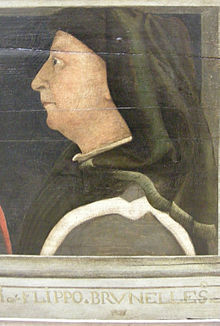Filippo Brunelleschi (/ˌbruːnəˈlɛski/ BROO-nə-LESK-ee, Italian: [fiˈlippo brunelˈleski], also known as Pippo;[2] 1377 – 15 April 1446) was one of the most important architects of the Italian Renaissance and an inventor of the perspective. All of his most well-known works are in Florence, Italy.
Filippo Brunelleschi | |
|---|---|
 | |
| Born | Filippo di ser Brunellesco di Lippo Lapi[1] 1377 Florence, Republic of Florence |
| Died | 15 April 1446 (aged 68–69) Florence, Republic of Florence |
| Known for | Architecture, sculpture, mechanical engineering |
| Notable work | Dome of Santa Maria del Fiore |
| Movement | Early Renaissance |
Biography
Early life
Brunelleschi was born in Florence, Italy in 1377.[3] His family consisted of his father, Brunellesco di Lippo, a notary and civil servant, his mother Giuliana Spini, and his two brothers.[4] The family was well-off; the palace of the Spini family still exists, across from the Church of the Trinita in Florence.[5]
Main works
The principal buildings and works designed by Brunelleschi or which included his involvement:
- Dome of the Florence Cathedral (1419–1436)
- Ospedale degli Innocenti (1419–ca.1445)
- The Basilica of San Lorenzo (1419–1480s)
- Meeting Hall of the Palazzo di Parte Guelfa (1420s–1445)
- Sagrestia Vecchia, or Old Sacristy of S. Lorenzo (1421–1440)
- Santa Maria degli Angeli: unfinished, (begun 1434)
- The lantern of Florence Cathedral (1436–ca.1450)
- The exedrae of Florence Cathedral (1439–1445)
- The church of Santo Spirito (1441–1481)
- Pazzi Chapel (1441–1460s)
Related pages
References
Other reading
Other websites
Wikiwand - on
Seamless Wikipedia browsing. On steroids.
